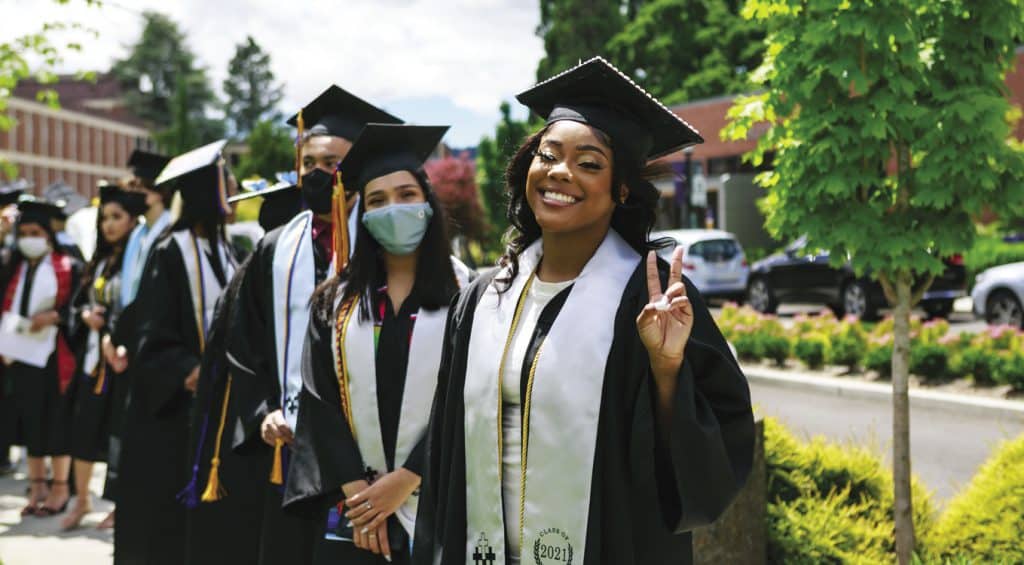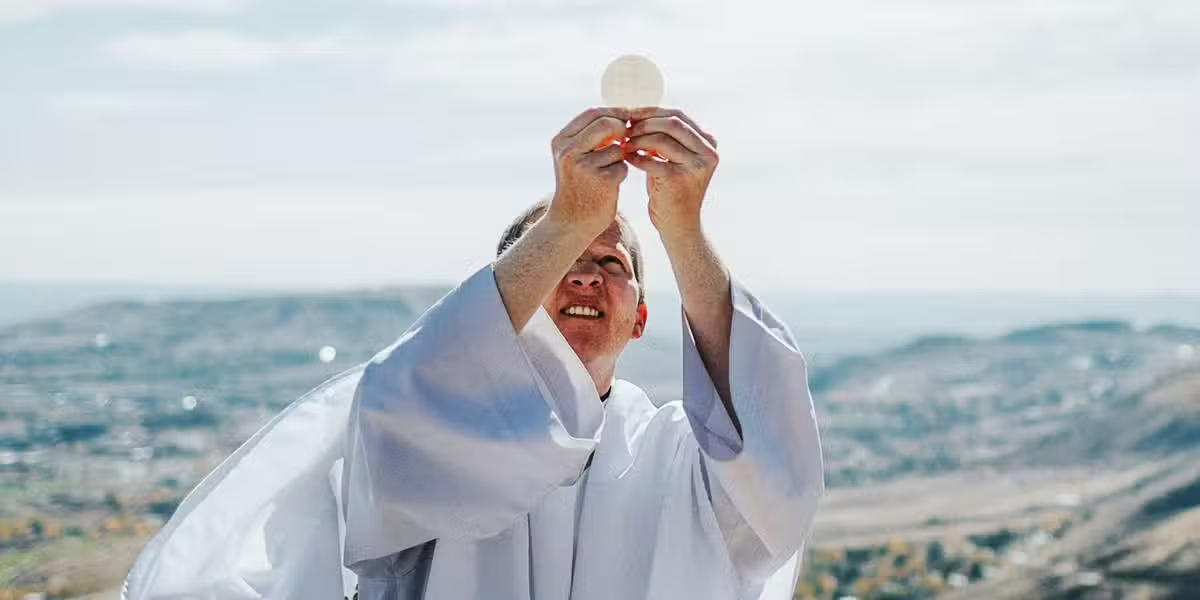First implemented 25 years ago, Cristo Rey high schools have survived declining enrollment, rising costs, and a pandemic. And they’re still going strong.
The Founders of an innovative schooling model certainly never dreamed their high schools would need to survive a financial crisis caused by a pandemic. In fact, the thinkers behind the Cristo Rey Network were simply responding to the Gospel call to serve those who need it most.
“The model was created out of a need to fund the students’ cost of education,” explains Morgan Collier, executive vice president at Cristo Rey Jesuit High School in Chicago. This school pioneered a new model intentionally created to serve families who could not pay tuition.
“The founders around the table knew the city of Chicago had generous Catholic corporate leaders and said, ‘Well, maybe the students can work to pay for their education by harnessing the generosity of those leaders,'” she says.
For decades, Catholic schools have relied on parishioner donations, steady tuition income from substantial enrollment, and a low-paid faculty of consecrated religious. Today, laity in need of living wages make up the vast majority of school faculty. Rising tuition quickly prices out middle- to low-income families. Enrollment was falling even before the pandemic caused many families to seek financial relief.
The Catholic innovators behind the Cristo Rey Network saw the writing on the wall and have already rethought their financial system for a new age. Though impacted by the economic downturn caused by the pandemic, these schools are weathering the storm and helping their students to thrive even in the toughest times.
A Downward Spiral
According to data released February 2021 by the National Catholic Educational Association (NCEA), an average of 100 Catholic schools close or consolidate every year. Few schools open to balance the loss; on average, only 15.
Financial woes caused by COVID-19 accelerated these closures. By the fall of 2020, over 200 Catholic schools had closed or consolidated. Most cite economic uncertainty: Tuition is unpaid, enrollment is plunging, and donations have dropped.
“The economics are a real challenge. It’s expensive to run a school; and to do so for the families who most deserve it, it’s impossible to ask them to pay more than they have,” explains Daniel Dougherty, president of Cristo Rey New York.
Elementary schools have borne the brunt of the pandemic, making up nearly 90 percent of the closures. But since those schools are a pipeline for high schools, they are a predictor of future trends. “Declines in enrollment at the primary grade levels may lead to a delayed but significant impact on secondary school enrollment within the next five to 10 years, proving potentially disastrous for secondary school viability,” reads the NCEA report.
Rethinking the System
The Cristo Rey model is a pioneering funding and educational structure tested in Chicago 25 years ago and now replicated in 38 high schools across the country, with a total enrollment of over 12,300 students. In contrast to the national trend, their school count during the summer of 2020 was unchanged by the pandemic: One school closed, but another opened. An additional Cristo Rey high school opened last fall, with another scheduled to open this year. Two more may be founded in coming years.
“We’re not affiliated with a parish, so we don’t rely on parishioner support for the school,” explains Collier. “Yet we’re also not driven by enrollment and tuition like so many other schools. If we take a hit in enrollment of 10 students, we’re not in jeopardy of closing, per se, because our revenue model is driven by the students that we have working for companies.”
In addition, Cristo Rey schools charge only minimal tuition from students, so families have been able to keep their kids in school even in tough times.
The Cristo Rey high school in the East Harlem neighborhood of New York City, in contrast to 20 school closures in their arch-diocese, actually had more students after the pandemic began and is currently at capacity.
“We don’t let ability to pay stand as an impediment to students attending,” explains Dougherty. “Our tuition is $2,000 a year, and it was $2,000 when we opened the school in 2004—it’s never gone up.”
Scholarships and grants mean that most families do not pay even that much. Nationally, Cristo Rey families pay an average of $788 per child per year. By comparison, it costs the school about $15,500 to educate each student.
An Innovative Model
If there is minimal tuition and no direct parishioner support, how does Cristo Rey pay the bills? They draw on the very resource they are attempting to foster: the students.
Students at a Cristo Rey school spend four days in the classroom with daily schedules that are slightly longer than the average high school. On the fifth day of the week, the students go to work in a real corporate setting with entry-level responsibilities, effectively paying for their own education.
“I think it’s a blessing,” says Kaela Dolmo of her corporate job. Kaela began her senior year at Cristo Rey New York last fall.
“My mom didn’t have as much opportunity as me. She went to Catholic school but only for a year because my grandma wasn’t able to financially support it. So I think that for me to help my mom actually support getting my education and actually doing the work to help pay, I think it’s amazing. I’m so happy that I can actually do it.”
These job opportunities are assigned by the school itself. Each Cristo Rey high school seeks out corporate partnerships to find work for their students. Law, accounting, and architectural firms; local government agencies; insurance companies; and tech businesses are just some of the groups that hire Cristo Rey students.
Sometimes the teens are placed at businesses that they could only dream of. Students from De La Salle North Catholic—a Cristo Rey high school in Portland, Oregon—have been hired by apparel giants Nike and Adidas. In New York, Kaela worked at Capital Group, one of the world’s largest investment organizations.
Cristo Rey schools are not attached to a parish. Most are sponsored by a religious order and draw students from a larger area than traditional Catholic schools. These families are attracted to the unique opportunity that Cristo Rey offers and are willing to travel for it. It took Kaela about 45 minutes, or “two trains and a bus,” to get to school.
“You need to be committed,” she explains. “The school’s committed to you; you have to be committed to actually do the work.”
Back to the Roots
The model may be new, but Cristo Rey schools see themselves as going back to the roots of Catholic education. The schools are intentionally founded in inner-city and low-income neighborhoods where they serve mainly minorities and immigrants. Their ministry is not unlike the beginnings of the Catholic school system in this country, founded by saints such as Elizabeth Ann Seton, Frances Xavier Cabrini, and Katharine Drexel, to educate the poor and outcasts of their days.
Nationally, minorities and urban communities are losing access to Catholic education at an alarming rate. According to the February 2021 data from the NCEA, “Underserved groups were over twice as likely to have their schools closed compared to all closures and all communities served by Catholic schools.”
The first Cristo Rey high school was founded in 1996 in the Pilsen neighborhood of Chicago, then known as a hot spot for drugs and gangs. A shuttered parish elementary school building was purchased and converted for secondary school use.
The goal was providing an excellent education for low-income, mostly first- and second-generation Mexican immigrants. The Cristo Rey plan was to give students entry-level corporate jobs that covered educational costs.

A graduate of De La Salle High School in Portland, Oregon, Zhada Allen now attends Clark Atlanta University, the first historically Black college or university in the South. She says Cristo Rey taught her, “You’re capable of doing anything, if you put your mind to it.”
The model worked. Within a few years, this first Cristo Rey high school was bursting at the seams and needed to expand the building.
“[My parents] just really had a huge concern, like my brothers or my sister and I falling into the wrong path because it was so common at the time,” says Chicago alumna Hilda Carrasco. The daughter of immigrants, Carrasco graduated in 2014 and now works at an accounting firm that employs Cristo Rey students. “By being at Cristo Rey, we were surrounded by a community that believed in us.”
By 2001, the model was replicated in Portland, Oregon. That school, De La Salle North Catholic, recently moved into a new, larger space—after renovating a parish elementary school that had been closed for 35 years—in order to accommodate the waiting list of students who want to attend.
Tim Joy, who retired as principal of De La Salle North Catholic in June 2021, lists current issues of “this time of trauma associated with the pandemic, but also the nation’s own reckoning with injustice and race.” Black, Hispanic, and minority students make up nearly 90 percent of the student body at his high school. “I think the kids at our school are the future of Portland,” he concludes.
Believe and Achieve
The Cristo Rey founders soon discovered that they had hit on an idea that was valuable from more than a financial perspective. Their students were thriving. For many, the corporate internship opened up a world of unexpected opportunity.
“Had it not been for Cristo Rey, a lot of us wouldn’t have even learned how to dress professionally,” explains Carrasco. Cristo Rey schools require businesslike uniforms and host training programs to teach new students corporate etiquette. “I think, overall, that just really helped give us an idea that we could see ourselves working in downtown [Chicago businesses],” she says, adding that her father worked low-paying factory jobs his whole life.
All Cristo Rey students leave high school with four years of corporate experience under their belt, something future employers find attractive. Many of them also leave with professional recommendations and networks that follow them into college and beyond. But on a much deeper level, the Cristo Rey corporate work-study program helps students realize what they can achieve.
That is what happened to Zhada Allen. A new graduate of De La Salle in Portland, she intends to study medicine in college, with the hopes that, in a few years, she’ll be “wearing that white coat and being an OB/GYN.”
Her freshman year at De La Salle, Zhada was placed to work as an assistant to an OB/GYN doctor. Her responsibilities included greeting patients, taking their vitals, preparing for examinations, and assisting during medical procedures.
“I was like, ‘I don’t know if this is going to be a good fit for me. I don’t know if I’m good enough,'” Zhada says. “You know, being only 15 and a freshman and you’re working in health care. . . . Do you trust me doing that? Should I be doing that?”
With the confidence and experience gained at her job, Zhada applied to 15 colleges and universities. She was accepted into all of them.
“The opportunity to get a college prep, academic education and to get exposure to the professional workplace seems to have a magical effect on student growth,” explains New York’s Dougherty. “Every one of our kids is admitted to a four-year college, and the class of 2020, every single one of them enrolled in a four-year college, even in the midst of the pandemic.” He compares Cristo Rey kids to students with similar socioeconomic backgrounds who, according to national statistics, usually enroll in college at half that rate.
“I’m amazed when—I’ve heard this from a couple of visitors—people come to the school and they’re just surprised. They come in, and kids walk up to them and say hello and say, ‘Can I help you?'” says Joy, the retired principal in Portland. “Our kids are different because of that whole experience of [being] surrounded by teachers and staff who care and love them and know them by name . . . and strong relationships with their supervisors.”
Beyond the Pandemic
The Cristo Rey model shows that, with innovation and dedication, there can be a bright future for Catholic schools, despite the present struggles.
“Parents yearn for schools that form character and focus on whole-child development,” says Elizabeth Goettl, president and CEO of the Cristo Rey Network, which oversees all the high schools following the model. “For future viability, schools need to perform at high levels in every respect, provide real value, [and] consider creative funding mechanisms that allow enrollment of students from middle- and low-income families.”
A model combining whole-student education with a low financial barrier carries an attractive power that could draw students, reverse declining enrollment, and revive the Catholic school system.
The Cristo Rey model will not work for every school. Elementary schools, of course, cannot send their students to work at corporations. But educators need to find other ways of providing excellent schooling without pricing out low-income families.
A century ago, Mother Frances Cabrini established 67 institutions in 35 years—including schools, hospitals, and orphanages. Catholic schools today need courageous innovators who are not afraid to strike out against all odds and follow the fresh promptings of the Holy Spirit.
As Cristo Rey shows, a thriving school system produces thriving students. Taught by educators listening to the Holy Spirit, the students are themselves ready to listen and change their world in their own time—which might come sooner than expected. For example, the new building for De La Salle North Catholic in Portland was partly designed by one of its graduates, now an employee of the architecture firm where he worked in high school.
“I knew that if I wanted to see change, I had to be that change,” explains Zhada of her decision to pursue a medical career after her experiences at Cristo Rey in Portland. In words that would hearten Catholic educators, she concludes, “You’re capable of doing anything, if you put your mind to it.”








